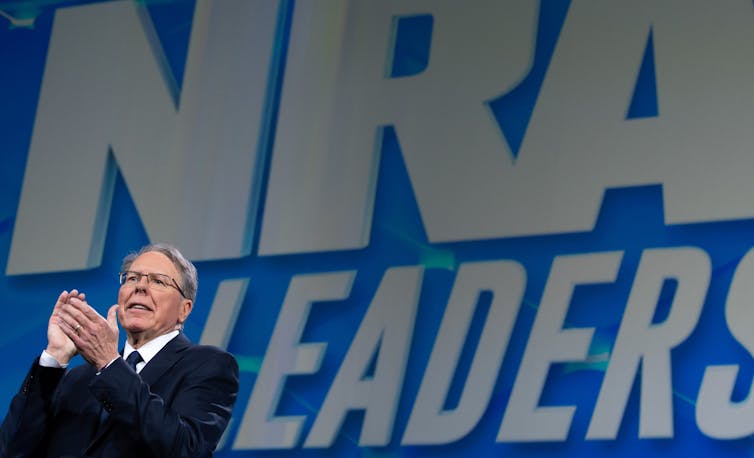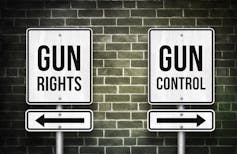Why I use the NRA as a case study for how nonprofits should NOT operate
 |
| Evidence of the gun group’s mismanagement under Wayne LaPierre’s leadership is mounting. Saul Loeb/AFP via Getty Images |
As I often explain to college and graduate students who are learning the basics of nonprofit management, all nonprofit boards of directors should ensure that those groups uphold their missions without wasting money.
These students also learn that it’s against the law for nonprofit board members or staff to benefit through the personal use of the group’s assets.
I began to use the NRA as a case study when serious allegations about its mismanagement emerged in 2019. The gun group’s wobbly finances and other woes make it the epitome of a poorly run nonprofit, because it violates four key legal and management principles.
Moving forward, I’ll draw on new information that emerged from the NRA’s bankruptcy trial, which a federal judge in Texas dismissed on May 11, 2021. The trial’s dismissal means that the NRA cannot carry through on its bid to use bankruptcy protection to get out of being sued by New York state authorities for alleged misdeeds.
1. No one running or overseeing a nonprofit should make a profit
During the NRA’s bankruptcy trial, Wayne LaPierre, its top executive, admitted he personally benefited from the organization’s assets beyond reasonable levels of compensation. He also suggested that he had stopped doing so – after “self-correction.”
Information the NRA disclosed in its 2019 tax filings shows that LaPierre, to whom the NRA paid US$1.9 million that year, had reimbursed the NRA $300,000, plus interest, for improper expenses, and that he faced another $75,000 in federal tax penalties. That same paperwork indicated that current and former NRA executives had received at least $1.3 million in “excess benefits,” as the organization had improperly paid for their meals, travel and sporting events.
New York authorities allege that LaPierre and others have diverted millions of dollars for themselves that should have been used to fund NRA operations. Among the lawsuit’s allegations is that LaPierre frequently took personal trips on private jets on the NRA’s dime. He procured personal benefits, including lucrative contracts, for board members, vendors and former employees.
On the list of LaPierre’s inappropriate expenses were golf memberships and millions of dollars of home security measures, improbably including $800 for mosquito treatment on his property. In 2019 the NRA began to negotiate to buy him a $6.5 million mansion in Dallas before the deal fell through.
New York’s complaint also alleges that the NRA had improper business dealings with board members and their firms. Approximately one-fourth of the 76-member board had contracts or made deals with the NRA, a practice that is legal only as long as the board determines the deal is “fair, reasonable, and in the corporation’s best interest.”
A board this size is inadvisable. Experts recommend that nonprofit boards have between eight and 14 members so they can act as one group, with each member feeling responsible. After critics blamed scandals at the American Red Cross in the early 2000s on the board’s large size, it was scaled back. That board now ranges between 12 and 20 members, down from about 50 in 2005.
 |
| Nonprofit boards are supposed to watch out for violations of nonprofit rules and regulations. sharpshutter/iStock via Getty Images Plus |
2. Nonprofit boards are responsible for good governance
A nonprofit board’s fiduciary duties include overseeing operations and ensuring that missions are upheld. Members must act in the organization’s interest rather than their own. They hire, supervise and, if necessary, fire the top executive.
Had the NRA’s board done its job, I doubt the gun group would be in all this trouble.
Instead of ensuring good governance, the NRA board has let it be run as “Wayne’s Kingdom,” in the words of Phillip Journey, a Kansas judge and NRA board member who testified during the bankruptcy trial. LaPierre actually hid the bankruptcy filing from most board members, the NRA’s top lawyer and its chief financial officer. In his decision to dismiss the bankruptcy case, Judge Harlin Hale said he found this lack of communication “nothing less than shocking.”
Board members who raised questions about the NRA’s activities say they lost committee assignments and were, on one occasion, told to “sit back, shut [your] mouth, stop asking questions, and trust that NRA management had everything under control.”
LaPierre also secured a $17 million post-employment contract, without the board’s knowledge, according to the New York lawsuit.
Among the additional details regarding these transgressions that came to light during the bankruptcy trial, perhaps the most stunning has to do with a vendor’s 108-foot boat called Illusions. LaPierre said he sailed to the Bahamas on that yacht because he “was looking for a place to be safe” following mass shootings like those at Sandy Hook Elementary School in Newtown, Connecticut, and Marjory Stoneman Douglas High School in Parkland, Florida.
New York’s NRA complaint reads like a textbook case of governance failure. It alleges that the board neither followed its own procedures nor documented its compensation decisions. Its audit committee ignored its obligation to oversee internal controls, failed to review related-party transactions and brushed off whistleblowers.
It’s no wonder that several board members have resigned since 2019, when irregularities became harder to ignore.
The NRA now says it is making strides in the right direction through a “renewed commitment to good governance.” But with LaPierre remaining at its helm, and a board that’s still loyal to him after all these allegations, I question whether the organization can fully clean up its act.
 |
| Wayne LaPierre used to spend time aboard a yacht that belonged to an NRA vendor. He now says was a ‘mistake.’ Cavan Images/Getty Images |
Unsurprisingly, the NRA’s finances have suffered and its membership dues have fallen in recent years.
The NRA’s legal troubles cost $100 million from mid-2018 to mid-2020, according to leaked a recording reported by NPR.
That figure, of course, doesn’t include expenditures tied to the dismissed bankruptcy trial.
Other signs of financial mismanagement are surfacing. The NRA’s former chief financial officer, Woody Phillips, declined to testify at the bankruptcy trial. When his successor, Craig Spray, testified, he said he wasn’t informed in advance about the decision to file for bankruptcy and that he had concerns about the accuracy of the NRA’s 2019 tax filings. Spray left the NRA in January 2021.
Nonetheless, the NRA has insisted it is in its “strongest financial condition in years.” In turn, Hale said that this solvency would mean the NRA should be able to pay its creditors in full.
4. The purpose of a nonprofit is to advance its mission
A nonprofit with shoddy oversight undercuts its mission. At the least, the NRA could have devoted the money it’s spending on legal costs on its mission, which largely consists of protecting the Second Amendment rights of U.S. gun owners.
 |
| U.S. nonprofits are free to support strict or loose gun regulation, as long as they don’t break laws or flout regulations. gguy44/iStock via Getty Images Plus |
Whatever you think about that mission, that’s not related to the NRA’s legal troubles.
Because the nonprofit sector has room for opposing views or causes, it includes both groups that support abortion rights and groups that want abortion banned, just as there are organizations that want more restrictions on gun ownership and those seeking fewer such rules.
But all nonprofits have something in common. They agree to pursue their mission in exchange for tax breaks.
Any nonprofit that loses sight of that mission, as the NRA has done, runs the risk of losing that exemption and even of the right to keep operating. Given that the New York lawsuit asks for its dissolution and the Internal Revenue Service entered the bankruptcy proceeding as a creditor – which indicates it is examining the NRA’s actions – those outcomes have now become a real possibility.![]()
Elizabeth Schmidt, Professor of Practice, Nonprofit Organizations; Social & Environmental Enterprises, University of Massachusetts Amherst
This article is republished from The Conversation under a Creative Commons license. Read the original article.
[Over 100,000 readers rely on The Conversation’s newsletter to understand the world. Sign up today.]